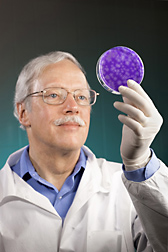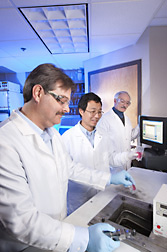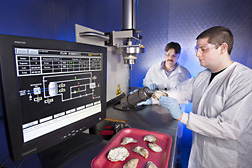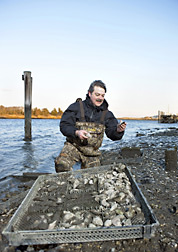Oysters, Clams, and Mussels
Keeping Popular Mollusks Safe To Eat
|
|
You don’t have to be a celebrity chef to cook a pot of delicious, freshly harvested mussels. Simmer them for about a half-hour in a simple broth of white wine and garlic, then serve with a ready-to-eat garden salad and some crunchy bread. You’ll have a hearty meal for family and friends to enjoy. In fact, mussels—easy to prepare and fun to eat—are one of America’s most popular kinds of seafood.
Of course, simmering, or any other means of cooking, helps ensure that you won’t pick up a foodborne pathogen when you eat a mollusk. But eating raw or undercooked mollusks—as many seafood fans prefer to do—may pose a safety hazard if the shellfish is harvested from waters polluted with pathogenic microbes.
That’s why enhancing the food safety of mouthwatering mollusks is the focus of David H. Kingsley, a molecular biologist; Gary P. Richards, a microbiologist; and technicians Gloria K. Meade, Brad Shoyer, and Michael A. Watson. Based in Dover, Delaware, they are the only ARS group working nearly exclusively on molluscan food safety. The team is in the ARS Eastern Regional Research Center’s Food Safety and Intervention Technologies Research Unit.
Microbes that cause human illness can make their way into mollusk tissues when the bivalves open their shells to feed, taking in, filtering, and expelling seawater. As a result of this filter-feeding, pathogens can “bioconcentrate” within shellfish meat.
Microbes of concern include viruses such as norovirus, the number-one cause of foodborne illness in the United States, and hepatitis A virus, which causes a contagious liver disease. Also of concern are bacteria such as Vibrio vulnificus, which can cause serious infection, or V. parahaemolyticus, a cause of gastroenteritis.
Enlisting Science To Detect, Identify, and Deactivate Microbes
In current investigations, the researchers are developing new, high-tech assays that regulatory agencies, public health officials, and seafood processors could use to detect and identify these or other pathogens in shellfish. The scientists are exploring new ways to decontaminate mollusks while protecting the seafood’s flavor, texture, and color.
Kingsley, for example, is investigating the use of a specialized procedure known as “high-pressure processing,” or HPP, to inactivate viruses, specifically norovirus and hepatitis A virus.
HPP isn’t new. For example, it is used commercially for deli meats and to pasteurize some juices. Some shellfish processors use it to deactivate Vibrio bacteria. But Kingsley and co-workers are the first to show that HPP can inactivate some foodborne viruses.
How HPP Works
The HPP equipment compresses water in a tank to create intense pressures—as high as 90,000 pounds per square inch (psi). That’s in contrast to normal atmospheric pressure, which is about 15 psi at sea level.
In early studies to determine whether norovirus is susceptible to HPP treatment, the researchers worked with a mouse norovirus as a substitute, or surrogate, for the norovirus that causes illness in humans. Human norovirus can’t be grown in the laboratory, but the mouse norovirus can.
“The mouse norovirus is closely related to human norovirus, so it is a relevant surrogate,” says Kingsley. Results indicated that 99.99 percent of the mouse norovirus, bioconcentrated by oysters grown in laboratory tanks, was inactivated by treating the oysters with HPP for 5 minutes at 60,000 psi.
As a further test of the HPP treatment, the scientists blended oyster meat and mouse norovirus together and fed the mixture to laboratory mice known to be highly susceptible to the virus. None of the mice tested positive for the virus.
The impact of the HPP treatment on human norovirus is still being explored, Kingsley notes.
HPP Inactivates Hepatitis A Virus, Too
In tests targeting the hepatitis A virus, Kingsley and coinvestigators determined that the same pressure treatment of 60,000 psi for 5 minutes inactivated 99.9 percent of the virus that had been bioconcentrated by oysters in laboratory tanks. The results were the same whether the treatment targeted in-shell oyster meat or oyster meat that had been removed from the shells.
|
|
The hepatitis A studies led to collaboration with researchers in Italy, where raw or lightly cooked Mediterranean mussels, popular in European markets, are sometimes a vector for the virus. The Dover scientists and colleagues from the University of Bari in Italy found that the 5-minute, 60,000-psi treatment inactivated 99.9 percent of the virus in North American blue mussels and in Mediterranean mussels. The Bari researchers are looking into possible commercial use of the process in Europe.
HPP works by damaging a virus’s outer layer, known as a “capsid,” or a bacterium’s membrane. Without protection of a capsid or membrane, the microorganisms can’t survive.
With all of its promise, HPP is not yet perfect. The equipment is expensive. The pressures needed to inactivate norovirus and hepatitis A are higher than what is commercially used currently for Vibrio inactivation and may alter the meat’s taste and texture somewhat. “We have some ideas that might resolve this,” says Kingsley.
In addition to his ARS colleagues at Dover, Kingsley’s coinvestigators include Kevin R. Calci with the U.S. Food and Drug Administration, Dauphin Island, Alabama; Haiqiang Chen and Dallas G. Hoover at the University of Delaware-Newark; George J. Flick and Daniel R. Holliman (deceased), Virginia Polytechnic Institute and State University-Blacksburg; Robert M. Gogal and Richard Kerr, University of Georgia-Athens; Juan S. Leon and Christine L. Moe of Emory University, Atlanta, Georgia; and Valentina Terio at the University of Bari.
The scientists have published their findings in the following journals: Applied and Environmental Microbiology, Food and Environmental Virology, International Journal of Food Microbiology, Journal of Food Protection, and Virus Research.—By Marcia Wood, Agricultural Research Service Information Staff.
This research supports the USDA priority of ensuring food safety and is part of Food Safety, an ARS national program (#108) described at www.nps.ars.usda.gov.
David H. Kingsley is in the USDA-ARS Food Safety and Intervention Technologies Research Unit, Eastern Regional Research Center, J.W.W. Baker Center, Delaware State University, Dover DE 19901; (302) 857-6406, david.kingsley@ars.usda.gov.
Steak! Researchers Give It a Grilling
Steak is an all-American favorite. To help make sure that E. coli O157:H7 and some of its Shiga-toxin-producing relatives will not ruin the pleasure of this popular entrée, ARS researchers have tested the effects of grilling on these microorganisms.
In particular, they’re learning more about the movement of E. coli into “subprimals,” the meat from which top sirloin steaks are carved. Their focus is on what happens to the E. coli when subprimals are punctured, as part of being tenderized, and the effect of gas-grill cooking on survival of those microbes. The concern is whether tenderizing processes move significant amounts of E. coli cells into the deep interior tissues of the meat, says microbiologist John B. Luchansky with ARS’s Eastern Regional Research Center in Wyndmoor, Pennsylvania.
In the study, scientists applied various levels of E. coli O157:H7 to the lean surface of subprimals, ran the meat (lean side up) through a blade tenderizer, then took core samples from 10 sites on each subprimal, to a depth of about 8 centimeters. In general, only 3 to 4 percent of the E. coli O157:H7 cells were transported to the geometric center of the meat, they found. At least 40 percent of the cells remained in the top 1 centimeter. “Knowing where a pathogen is most likely located—in or on steaks—is the first step toward validating proper cooking methods and temperatures for killing it,” Luchansky says.
To learn more about the effects of grilling, the group examined other subprimals, applying E. coli O157:H7 to the lean surface, running the subprimals once through the blade tenderizer (lean side up), then slicing the meat into steaks either ¾-inch, 1-inch, or 1¼-inch thick. Using a commercial open-flame gas grill they cooked the steaks—on both sides—to an internal temperature of 120˚F (very rare), 130˚F (rare), or 140˚F (medium rare).
“Our findings confirm that if a relatively low level of E. coli O157:H7 were to in fact be distributed throughout a blade-tenderized top sirloin steak, proper cooking on a commercial gas grill is effective for eliminating it,” Luchansky says.
He did the work with Wyndmoor colleagues Jeffrey E. Call, Bradley Shoyer, and Anna C.S. Porto-Fett; Randall K. Phebus of Kansas State University; and Harshavardhan Thipparredi of the University of Nebraska. Articles published in the Journal of Food Protection in 2008 and 2009 document these preliminary findings.
This research was funded by the Beef Checkoff and the USDA Food Safety and Inspection Service as well as ARS.—By Marcia Wood, Agricultural Research Service Information Staff.
"Oysters, Clams, and Mussels: Keeping Popular Mollusks Safe To Eat" was published in the April 2011 issue of Agricultural Research magazine.










